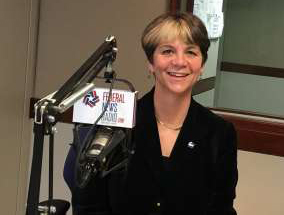
How NASA plans on ensuring that its data is accessible forever
Renee Wynn, the NASA CIO, said during the upcoming ACT-IAC ELC ImaginationNation conference she’s interested in learning about SDN and zero trust networks.
Best listening experience is on Chrome, Firefox or Safari. Subscribe to Ask the CIO’s audio interviews on Apple Podcasts or PodcastOne.
As NASA prepares to return to the moon, scientists and researchers are reviewing the data from the 1969 Apollo mission.
This instance is an example of the bigger challenge the space agency faces — how to keep its data accessible to continue to pull out value from decades later.
Renee Wynn, the NASA chief information officer, said she hopes to use the upcoming to ImaginationNation Executive Leadership Conference sponsored by ACT-IAC to further develop the agency’s plans to tame their big data challenge.
“One of the things I want to look at is who may have come up with tools on data access, especially data that is different ages, kept in different formats but still electronically available and has a high return rate on what the individual might be looking at,” Wynn said on Ask the CIO. “I also want to look at smart cloud use. NASA brings down more and more data from the universe … and what we’ve got to do is look at smart cloud. One of the things about going to the cloud is very exciting is the scalability of it, however you have to begin by designing your systems to be in the cloud, and if you are designing your systems to have connectivity to space there are few more checkpoints that we have to go through in order to make sure the data comes down, retains its highest integrity and then is quickly available for scientists all over the globe.”

Currently, NASA’s data is in all the formats over the last 60-plus years from paper to magnetic tape to electronic formats like PDF and is structured and unstructured.
Wynn said she wants to improve the agency’s ability to search unstructured data.
To that end, NASA is testing how artificial intelligence could solve this challenge.
Wynn said NASA is using AI to search email that match federal record requirements.
“We have a 97 percent success rate. We are working with NARA to share that technology with them to be thought about potentially scaled, but take a thoughtful approach about how we could apply this across the government,” she said. “We have been piloting this for about a year. The idea of the pilot is to see what the success rate is and 97 percent success rate means we may be missing something. We are digging into how we can increase the percentage of success so we aren’t missing records.”
An important piece of this records management puzzle is how NASA modernizes its network.
Wynn said software-defined network and zero trust networks are a key part of the cloud smart strategy.
“There is no edge to your network. In fact, it’s not even on the globe,” she said. “We need to be looking at who is doing SDN, how do we build in and drive toward zero trust networks.”
Wynn also said she’s looking to the ImaginationNation event to better understand where NASA could use blockchain technology to manage its supply chain as well as how digital transformation is changing the way agencies conduct engineering activities.
In many ways, Wynn’s focus areas are similar to those of many CIOs.
Tony Scott, the CEO of the Tony Scott Group and the former federal CIO, said something like the promise of SDN means the ability for agencies to vastly improve how they secure their systems and data.
“With a SDN, you have the opportunity to have a more fine-grained set of controls in your network environment,” he said. “The old notion of a network is everything can connect to everything else all the time that is on that network. But with a SDN, you have the opportunity to say this server can only connect to this database and nothing else should be able to get to it, as one simple example. That gives you the opportunity to fine tune the network in ways that we just we had a lot more trouble before with defining access control lists and a lot more complicated mechanisms. And because you can do it in software means you can do whatever you need to do faster and more flexibly.”
Scott added that even with things like blockchain, there are opportunities to use it really in any place where you’d want a record, like personnel records or software is signed as valid, that’s indelible and can’t be altered easily.
Wynn said NASA has funded a few really small blockchain pilots that are just getting started to see how it could work.
“As we go with more software and the benefits of that SDN, blockchain would potentially be looking at who is doing the coding, where they are located geographically and the blockchain part could help you understand the pedigree associated with that software’s life from coding to a package you may bring into the agency,” she said.
Copyright © 2024 Federal News Network. All rights reserved. This website is not intended for users located within the European Economic Area.
Jason Miller is executive editor of Federal News Network and directs news coverage on the people, policy and programs of the federal government.
Follow @jmillerWFED
Related Stories






